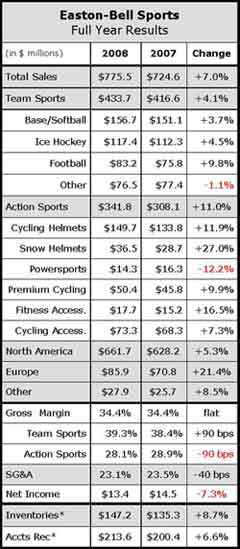 Driven by strength in both of its major product segments, Easton-Bell reported revenues for the fourth quarter fiscal 2008 increased 9.1% to $169.2 million from $155.1 million in Q4 2007.
Driven by strength in both of its major product segments, Easton-Bell reported revenues for the fourth quarter fiscal 2008 increased 9.1% to $169.2 million from $155.1 million in Q4 2007.
Management noted that strength in baseball and softball products and football helmets and reconditioning services were the primary drivers for the quarter for Team Sports, which saw revenues increase 5.8%. These segments, along with a hockey line that boasts Eastons first helmet, also contributed to a year-over-year spike in revenues. Management noted products propelling growth in Team Sports were shoulder pads and Riddells Revolution Speed football helmet and the S17 Stealth hockey stick.
They added that Team Sports apparel had been slightly softer and had been more reflective of schools cutting their budgets.
For Action Sports, which increased 13.1% for the quarter, management said strength in cycling helmets and accessories in both the Mass and Specialty channels, along with increased sales for snow sports and powersports helmets and eyewear in the Specialty channel, drove growth for the category.
For the year, gross margins were 39.3% for Team Sports and 28.1% for Action Sports. Operating income generated from Team Sports increased 3% to $73.0 million from $70.8 million last year, while operating income from Action Sports increased 15% to $35.6 million from $30.2 million a year ago.
Fourth quarter gross margins declined 120 basis points to 30.2% of sales, compared to 31.4% of sales in the year-ago quarter. Income from operations was $4.3 million, a 50% increase from $2.1 million a in the year ago period. The net loss for Q4 was $10.8 million as compared to a net loss of $5.7 million in the year-ago period.
Full year SG&A expenses, which increased 5.4% to $179.2 million compared to $170.0 million last year, improved 40 basis points on a percent-of-sales basis. Management said the regression in SG&A expenses reflects “the improved leverage of our fixed cost infrastructure and significant reduction in Sarbanes-Oxley compliance cost.” Management noted the decrease in SG&A expenses also contributed to operating income, which increased 9.5% to $73.3 million from $67.5 million in the year ago period.
The year-over-year increase in inventories came in the companys Mass business, which management said will substantially be reduced as the peak season arrives. Management added that sell-through had “dropped a little bit” for the Mass channel in Q4, but has since picked up in the first quarter of fiscal 2009. Representatives for the company said the company had seen very positive results after shipping cycling products to Target.















